YouTube Search Export
The YouTube Search Export automation extracts video details such as titles, descriptions, view counts, and upload dates from YouTube search results. Ideal for marketers and researchers, it supports bulk input, scheduling, and export to Google Sheets or CSV, enabling efficient trend analysis, content strategy development, and competitor research.
Tutorial
Overview
The YouTube Search Export automation allows you to extract video details such as titles, descriptions, upload dates, view counts, and more from YouTube search results. This tool is ideal for marketers, researchers, and growth hackers looking to analyze trends, build datasets, or conduct competitor research. You can export the data to Google Sheets or CSV for seamless tracking and organization. Follow this guide to set up and run the automation.
Step 1: Log in to the TexAu App and Locate the Automation
Log in to your TexAu account at v2-prod.texau.com. Navigate to the Automation Store and search for YouTube Search Export. Click on the automation to open its configuration screen.
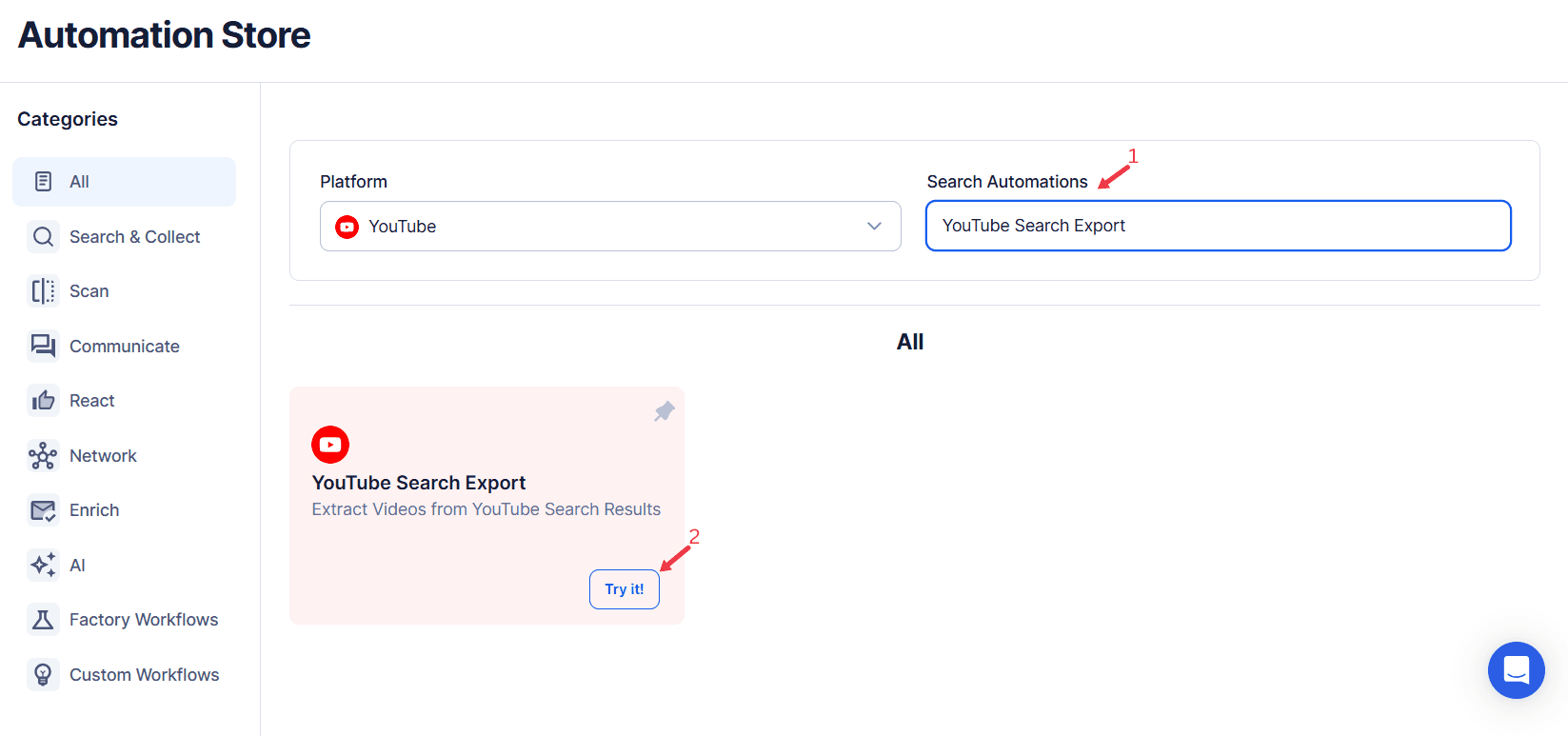
Step 2: Select Your Input Source
TexAu offers a comprehensive YouTube Search Export automation to collect video data based on specific search queries. This tool is ideal for researchers, marketers, and content creators aiming to analyze trends, competitors, or topics of interest.
Specify the YouTube search query or URL. TexAu supports the following input methods:
Single Input
Use this option to extract data for a single YouTube search query.
- Search URL: Enter the YouTube search results URL (e.g.,
https://www.youtube.com/results?search_query=AI) to gather videos related to your query. - Extract Limit (Optional): Define the maximum number of videos to extract (up to 500 per launch).
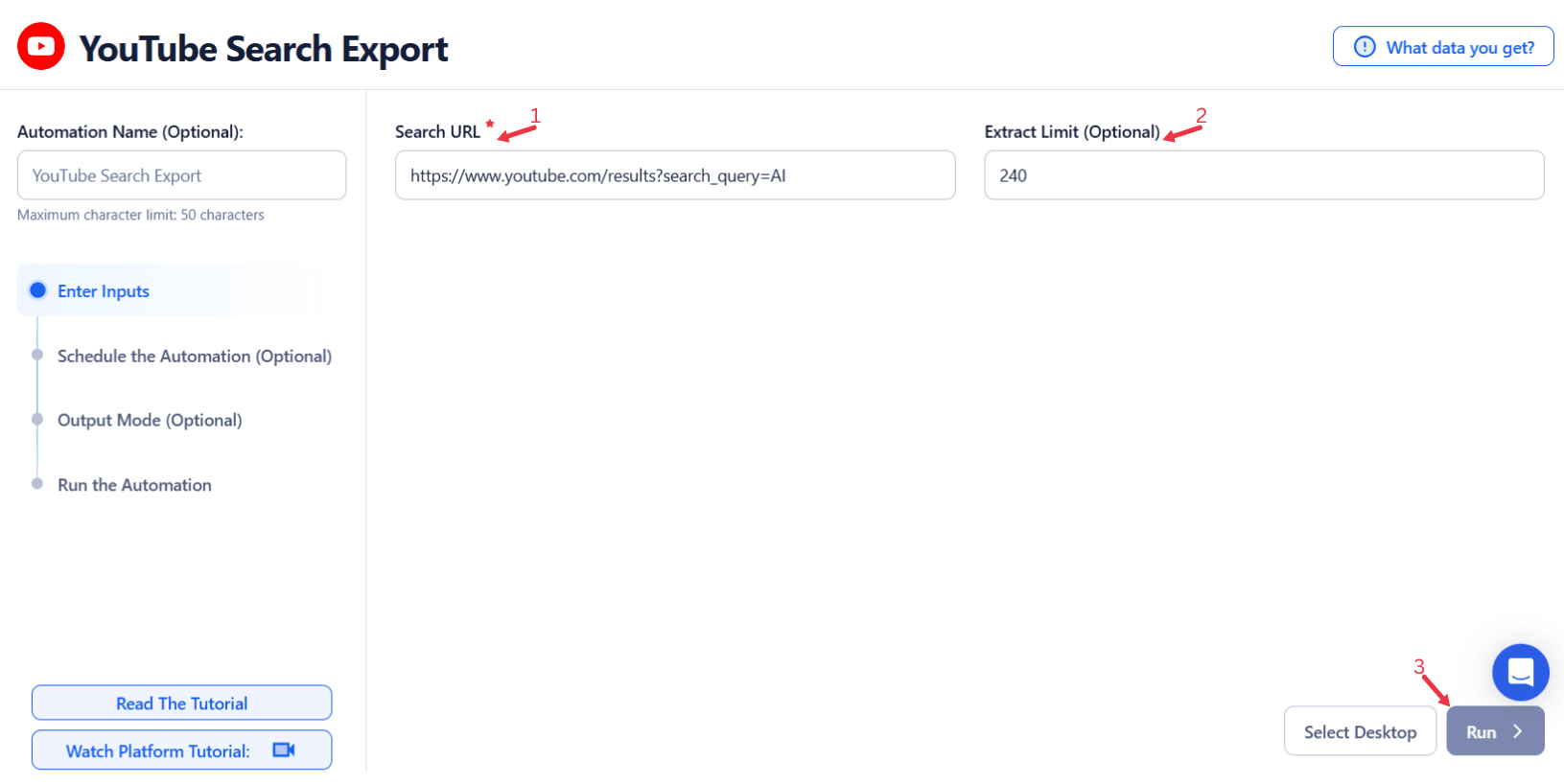
Google Sheets
This method is best suited for extracting video data from multiple search queries listed in a Google Sheet.
- Connect your Google account
- Click Select Google Account to choose your connected account or Add New Google Sheet Account to link a new one.
- Select your spreadsheet
- Click Open Google Drive to locate the sheet with YouTube search URLs.
- Choose the spreadsheet and the specific sheet where your data is stored.
- Adjust processing options
- Number of Rows to Process (Optional): Specify the number of rows to process from the sheet.
- Number of Rows to Skip (Optional): Define the rows to skip if necessary.
- Provide input details
- Search URL: Ensure the correct column contains valid YouTube search URLs.
- Extract Limit (Optional): Specify the extraction limit for each URL.
Enable Loop Mode (Optional)
- Turn on Loop Mode to reprocess the Google Sheet from the beginning once all rows are completed.
Watch Row (Optional)
With Watch Row, automations become effortless as new Google Sheet rows are detected and processed automatically. This keeps processes running smoothly without intervention.
To configure, choose a scan frequency and set the start and end dates.
Watch Row Schedule:
- None
- At Regular Intervals (e.g., every 15 minutes or every hour)
- Once
- Every Day
- On Specific Days of the Week (e.g., every Tuesday and Friday)
- On Specific Days of the Month (e.g., the 9th and 28th)
- On Specific Dates (e.g., January 4)
The system refreshes every 15 minutes and stops monitoring after five days, unless modified.
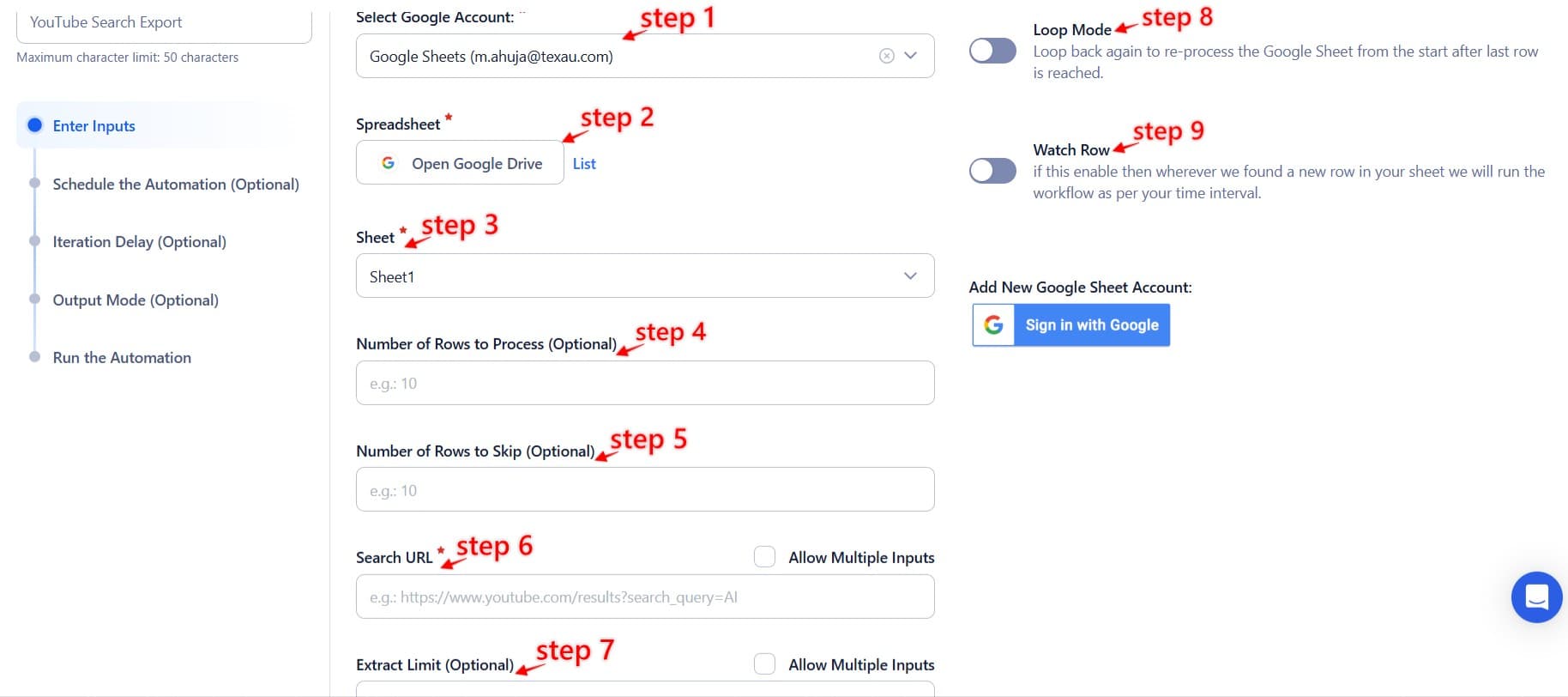
Process a CSV File
This option allows you to extract video data for search queries listed in a CSV file.
- Upload the file
- Click Upload CSV File and select the file containing YouTube search URLs.
- TexAu will preview the file for verification.
- Adjust processing settings
- Number of Rows to Process (Optional): Define how many rows to process.
- Number of Rows to Skip (Optional): Specify the rows to skip if needed.
- Provide input details
- Search URL: Ensure the appropriate column contains the YouTube search URLs.
- Extract Limit (Optional): Specify the extraction limit for each URL.
Tip:
- Use Google Sheets for dynamic or frequently updated data.
- Use CSV files for static datasets that require no frequent updates.

Step 3: Execute Automations on TexAu Desktop or Cloud
- Open the automation setup and select Desktop Mode.
- Click Choose a Desktop to Run this Automation.
- From the platform, select your connected desktop (status will show as "Connected") or choose a different desktop mode or account.
- Click “Use This” after selecting the desktop to run the automation on your local system.
- Alternatively, if you wish to run the automation on the cloud, click Run directly without selecting a desktop.

Step 4: Schedule the Automation (Optional)
To run the export at specific times, configure the Schedule settings:
- None: Run the automation immediately.
- At Regular Intervals: Set to repeat every few hours or daily.
- Once: Specify a one-time run at a particular date and time.
- Every Day: Automate scraping daily at a chosen time.
- On Specific Days of the Week: Choose specific days such as Monday or Friday.
- On Specific Days of the Month: Select specific dates like the 1st or 15th.
- On Specific Dates: Define exact dates for running the automation.
Tip: Scheduling ensures your data is regularly updated without manual intervention.
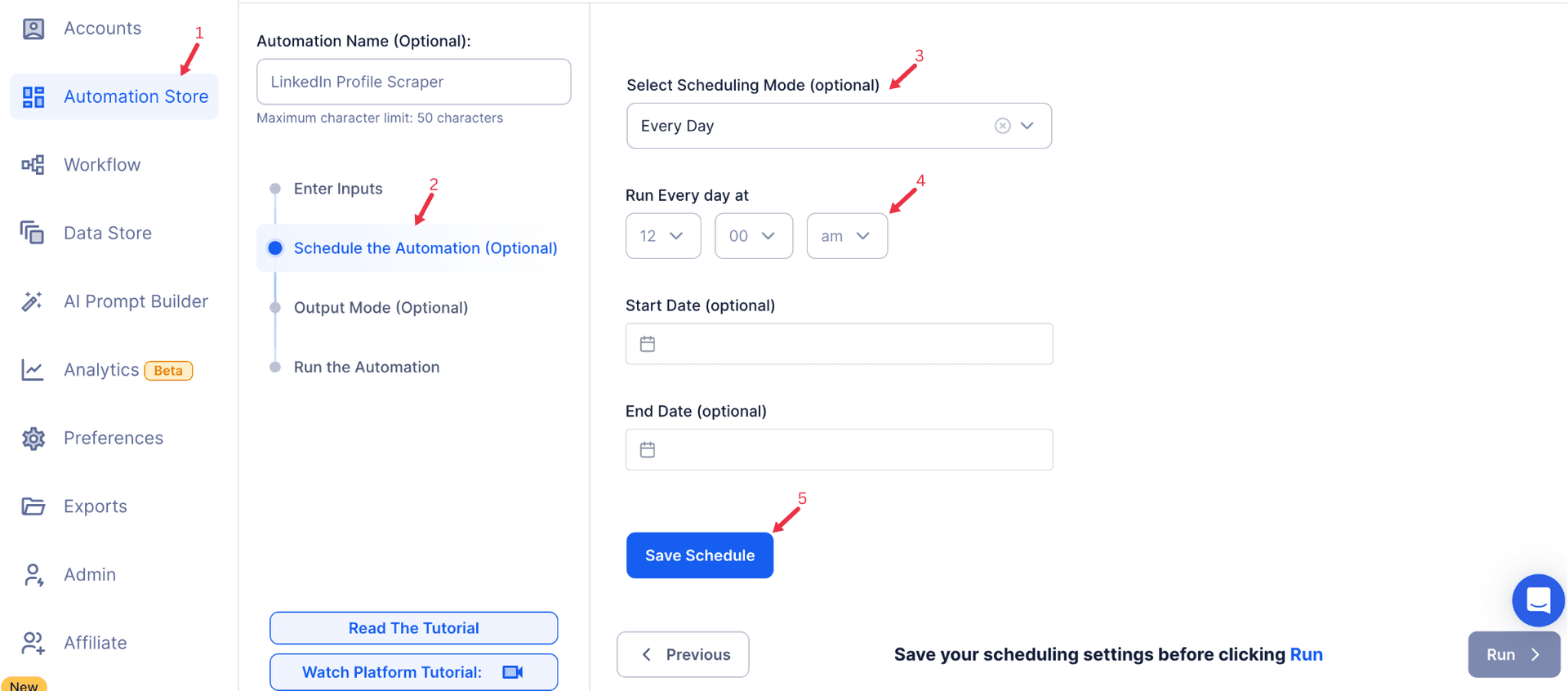
Step 5: Set an Iteration Delay (Optional)
Avoid detection and simulate human-like activity by setting an iteration delay. Choose minimum and maximum time intervals to add randomness between actions. This makes your activity look natural and reduces the chance of being flagged.
- Minimum Delay: Enter the shortest interval (e.g., 10 seconds).
- Maximum Delay: Enter the longest interval (e.g., 20 seconds).
Tip: Random delays keep your automation safe and reliable.
Screenshot Suggestion: Include a screenshot of the Iteration Delay settings, showing fields for Minimum Delay, Maximum Delay, and time units.

Step 6: Choose Your Output Mode (Optional)
Choose how to save and manage the extracted alumni data. TexAu provides the following options:
Append (Default): Adds new results to the end of existing data, merging them into a single CSV file.
Split: Saves new results as separate CSV files for each automation run.
Overwrite: Replaces previous data with the latest results.
Duplicate Management: Enable Deduplicate (Default) to remove duplicate rows.
Tip: Google Sheets export makes it easy to collaborate with your team in real time, particularly useful for alumni network management and analysis.
Screenshot Suggestion: Show the Output Mode settings with options for Google Sheets, CSV, Append, Split, and Deduplicate
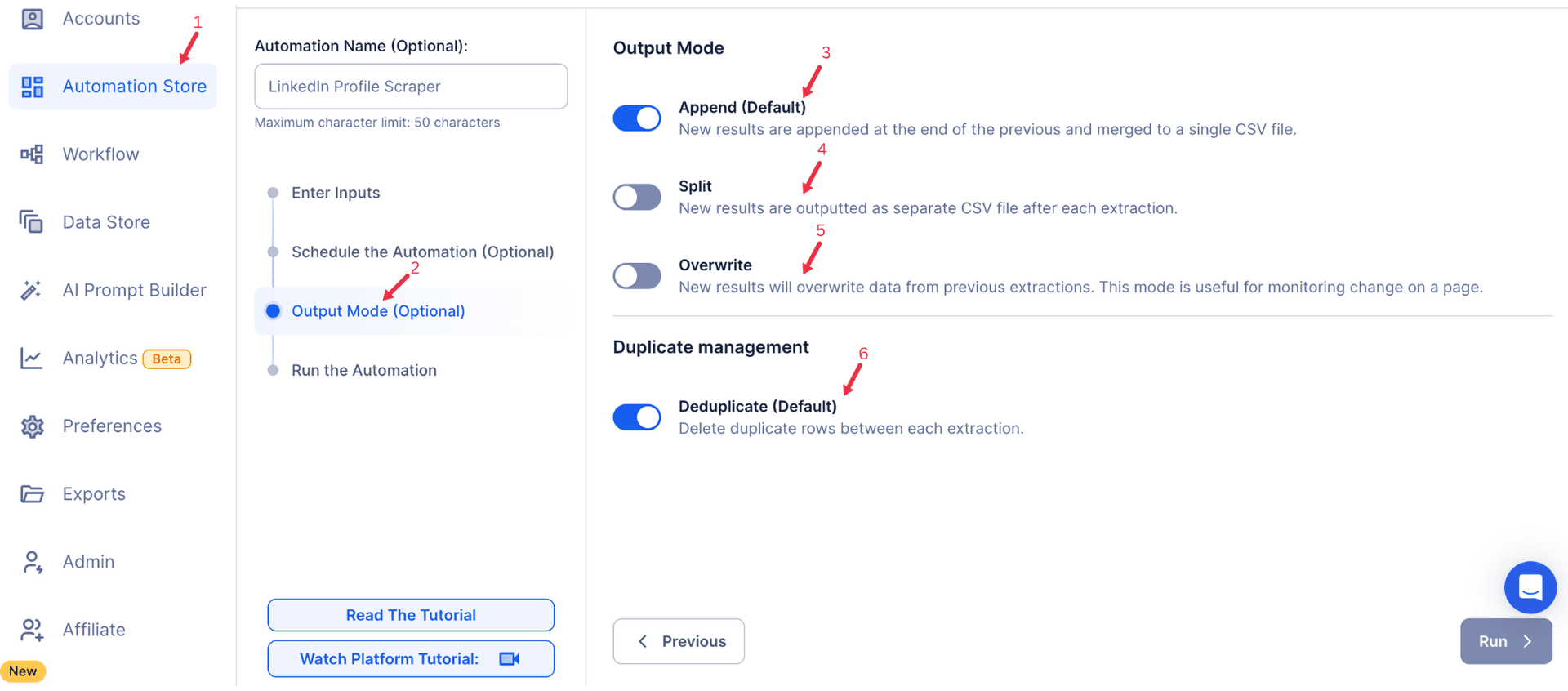
Step 7: Access the Data from the Data Store
After the automation completes, access your results in the Data Store:
- Navigate to Data Store in TexAu.
- Locate the YouTube Search Export automation.
- Click See Data to view or download the exported search results.

The YouTube Search Export automation streamlines the process of collecting video details from YouTube search results. With features like bulk input, scheduling, and data export to Google Sheets or CSV, it supports efficient research, content strategy development, and competitive analysis for marketers and researchers.
Recommended Automations
Explore these related automations to enhance your workflow
YouTube Channel Scraper
The YouTube Channel Scraper automation extracts detailed data from YouTube channels, including names, subscriber counts, and video counts. Ideal for marketers and researchers, it supports bulk input, scheduling, and export to Google Sheets or CSV, enabling efficient competitive analysis, trend research, and data-driven content strategy development.
YouTube Channel Videos Scraper
The YouTube Channel Videos Scraper automation extracts video details such as titles, descriptions, upload dates, and views from YouTube channels. Ideal for marketers and researchers, it supports bulk input, scheduling, and export to Google Sheets or CSV, enabling efficient data collection for content analysis, trend tracking, and marketing strategy development.
YouTube Video Scraper
The YouTube Video Scraper automation extracts detailed video information, including titles, descriptions, view counts, and upload dates. Ideal for marketers, researchers, and content creators, it supports bulk input, scheduling, and export to Google Sheets or CSV, enabling efficient trend analysis, audience research, and data-driven content strategy development.
Google Search Results Scraper
TexAu's Google Search Results Scraper lets you extract structured SERP data in bulk. Automate keyword tracking, SEO research, and competitor insights with API support and simple setup. Ideal for growth hackers, marketers, and analysts.
Twitter List Members Export
Export the complete list of members in any Twitter list using the Twitter List Members Export tool. Ideal for marketers and brands to analyze and engage with specific communities or audiences. Simplify data management and refine your outreach today!
GitHub Contributors Export
TexAu’s GitHub Code Search Export tool helps you extract specific code search results from GitHub using keywords or URLs. It automates the process and lets you export results in CSV format, making it easier to analyze or share data. Ideal for developers, researchers, and analysts who need fast and structured GitHub code search exports.
Reddit User Search Export
The Reddit User Search Export automation extracts user data from Reddit based on keywords or subreddits. Ideal for marketers and researchers, this tool enables targeted user analysis and insights. Export data seamlessly to Google Sheets or CSV, with scheduling and bulk processing options.
Reddit User Posts Export
The Reddit User Posts Export automation extracts posts made by specific Reddit users, enabling detailed activity analysis and content tracking. Configure easily and export data to Google Sheets or CSV, with options for scheduling and cloud or desktop execution.

Start your 14-day free trial today, no card needed
TexAu updates, tips and blogs delivered straight to your inbox.

